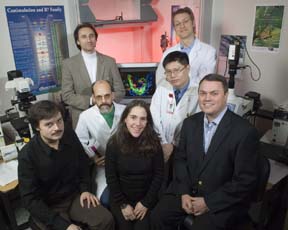Weill Cornell researchers score a Nature quadruple play
By Ernie Mundell

Publication in the journal Nature is a coup for any research team, but Weill Cornell Medical College (WCMC) investigators have earned recognition in the journal four times in recent months with landmark findings in fields as diverse as HIV microbicides, ion channel function, neuronal growth and cancer metastasis.
The cancer findings, especially, "could open up a whole new door to identifying and treating metastatic disease before it starts," explained first author Rosandra Kaplan, the Charles, Lillian and Betty Neuwirth Clinical Scholar in Pediatric Oncology. As reported in the Dec. 8 issue of Nature, Kaplan and senior lead researcher David Lyden led a team that moved beyond examination of metastatic cells or even their "microenvironment" to a third party deeply involved in creating what they call the "premetastatic niche" at the site of secondary disease.
The paper also sets forth the intriguing concept that tumor metastasis may not only be dependent on the oncogenicity of the tumor cells, but also on the existence of developmentally bookmarked permissive niches or "hot spots" that are receptive for tumor metastasis. According to Shahin Rafii, the Arthur B. Belfer Professor of Genetic Medicine and co-author of the article, "It is conceivable that the number and the capacity of these hot spots to permit lodgment of tumor cells may be determined by the genetic makeup of any given patient. This may explain why subsets of patients with early stage colon cancer are more prone to liver metastasis, while others with an identical stage of cancer are cured from their disease with adjuvant therapy or timely surgical resection."
The Aug. 11 Nature was the forum for a second WCMC discovery with perhaps the broadest implications of all: that a mechanism crucial to the life of every cell may not be quite what it seemed.
Tiny cellular doorways called ion channels are so small that scientists still don't have a means of viewing them firsthand. And yet, ion channel dysfunction can wreak havoc and trigger diseases ranging from epilepsy to arrhythmias.
The opening and closing of these channels ("gating") relies on how the electrical charge of the protein is coupled to the membrane voltage. Explained the study's lead researcher Benoit Roux, professor of physiology and biophysics, "Because the electrical output mirrors that of simple electrical circuits [measured energy is equal to charge times voltage], it was naively thought that the gating charge would traverse the entire membrane -- the so-called 'big movement' mechanism."
Samie Jaffrey, assistant professor of pharmacology and the senior author of a third Nature paper published in the Aug. 18 issue, noted, "We found that protein synthesis-- which occurs via the action of messenger RNA -- also occurs at the very tips of developing neuronal axons, in a structure called the growth cone, far away from the neuron's cell body." Said Jaffrey, "In fact, like a kind of self-guided missile, the axon uses its own mRNA to seek out new neural connections. It's an exciting discovery, a real first."
Finally, a report in the Nov. 3 issue of Nature noted that women now make up the majority of the estimated 40 million people living with HIV/AIDS, largely because they often have little control over the safety of sexual encounters. But a collaborative study led by WCMC and Tulane University researchers suggests that vaginal gels containing a combination of antiviral compounds might someday allow women some measure of protection and control.
Researchers including John Moore, Per Johan Klasse, Susan Schader and Thomas Ketas of Weill Cornell's Department of Microbiology and Immunology, along with Ronald Veazey of the Tulane National Primate Research Center, found a three-drug topical microbicide effective in shielding female macaques from infection with SHIV -- a hybrid of HIV and its simian cousin, SIV.
Two of the small-molecule compounds used in the combo gel originated with drug makers Bristol-Myers Squibb and Merck Inc., while the third, a peptide called C52L, was developed by study co-author and Weill Cornell associate professor of biochemistry Min Lu.
Ernie Mundell is a writer at Weill Cornell.
Media Contact
Get Cornell news delivered right to your inbox.
Subscribe